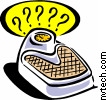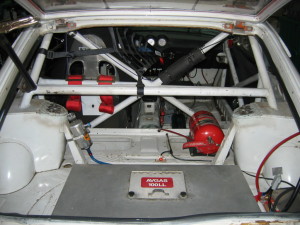No, this is not a ‘Woman’s Day’ article on how to lose ten pounds by walking from the back of the parking lot or by folding your laundry while jumping in place. I’m talking about putting your race car on a diet. A car’s acceleration potential is measured by its Weight-to-Power ratio, or how many pounds of car each horsepower must accelerate. A 2200 pound car powered by a 200 horsepower engine has a Weight-to-Power ratio of 2200:200, which can also be stated as 11:1. So every horsepower must push 11 pounds. If we can reduce the car’s weight to 2000 pounds, the ratio becomes 10:1, a 10% increase in acceleration potential.

Most race organizations have a minimum weight allowed for a specific car, and some have a minimum weight for the car and driver combined. Some race series, like NASA’s Performance Touring, have even classified the cars by Weight-to-Power ratio. They weighed and dynoed the cars to determine which class they would race in. A 3500 lb Camaro making 350hp would race against a 2500 lb BMW making 250hp, both in the 10-to-1 class. This is an imperfect system as engine torque is not taken into consideration, nor is the factor that a lighter car can change directions quicker or is easier on tires, but its a good way to classify vastly different cars into a somewhat equal format.
There are two major factors to take into consideration before putting your race car on a diet. First, you must be intimately familiar with your particular race group’s rules on car weight. If the minimum weight of your car is pretty much a stock car with a rollcage, then there is no weight to loose. There will be the issue of where this weight is located however: lower, centered, and sprung weight is better than higher, outboard, and unsprung weight, but we will get back to that issue later. Second, you need to prioritize your weight lose program, where will you get “the most bang for the buck”? Replacing a 12 oz steel bolt with a 6 oz titanium one might be cool, but it’s not the most cost effective way for a club race car to lose weight.
On the top of Racing On The Cheap’s “most bang-for-the-buck” weight loss program is removing anything that is not required for racing. That’s a free acceleration increase!
1-Bumpers – on my 240Z, the front and rear bumpers weighed about 10 lbs each, and were as far away from the car center as possible
2-Door windows and cranks – about 10 lbs per door
3-Interior components such as passenger seat, door panels, dashboard, and sound deadening material – up to a couple hundred lbs
4-Heater core and a/c system – up to 50 lbs
Next on the list are heavy components that are required but can be replaced by lighter ones.
5-Wiring – You can lose 10 lbs just removing the factory wiring harness, and replacing it with just what’s necessary.
6-Hoods and trunks/hatches – on the 240Z, the steel hood and steel/glass rear hatch weigh about 45 lbs each. Fiberglass replacements weigh about 15 lbs each and cost about $400 per piece. Carbon fiber replacements weigh about 5 lbs and cost about $800. Fiberglass looses 0.075 lbs per dollar. Carbon fiber looses 0.050 lbs per dollar, or 50% less cost effective. However that issue of weight location needs to come into the equation at this point. Weight high on the car (above its center of gravity) such as a hood, trunk, or windshield, causes more body roll during cornering, so it might be worth it to spend more to remove higher weight.
7-Wheels and tires, brake rotors and calipers – lightweight wheels can be 5-10 lbs lighter than stock, and race tires with thinner treads weigh a few lbs less than street tires. Aluminum calipers often weigh 5 lbs less than stock, while rotors may weigh more or less than stock depending on diameter increase, thickness decrease, and choice of material. The importance of weight lose with these four components is critical due its type – unsprung weight.. Here is a link about the importance and effect of unsprung weight, but there are books written on this subject alone. Again, this is an area where spending more to loose weight is probably worth it.
8-Shocks, springs, and control arms. Just like wheels and brakes, weight saved here is unsprung weight and worth the effort.
Then there are components that you have to add to a race car, such as safety equipment.
9-Seats – they come in steel, fiberglass, aluminum, and carbon fiber. Like every other part, lighter costs more, purchase accordingly. I decided on aluminum.
10-Roll cages – roll cages are necessary, and heavy. My car’s roll cage used 74 feet of 1.50″ OD x 0.12″ thick steel tubing that weighs 1.77 lbs per foot. Total weight of over 130 lbs, now that’s a lot of extra weight. So how much cage do you need? Enough to meet your club’s requirements at a minimum. Some more to add chassis stiffness in areas critical to improve handling. But sometimes racers just build more cage than’s neccesary, and that’s weight your car just doesn’t need.

Leave a Reply